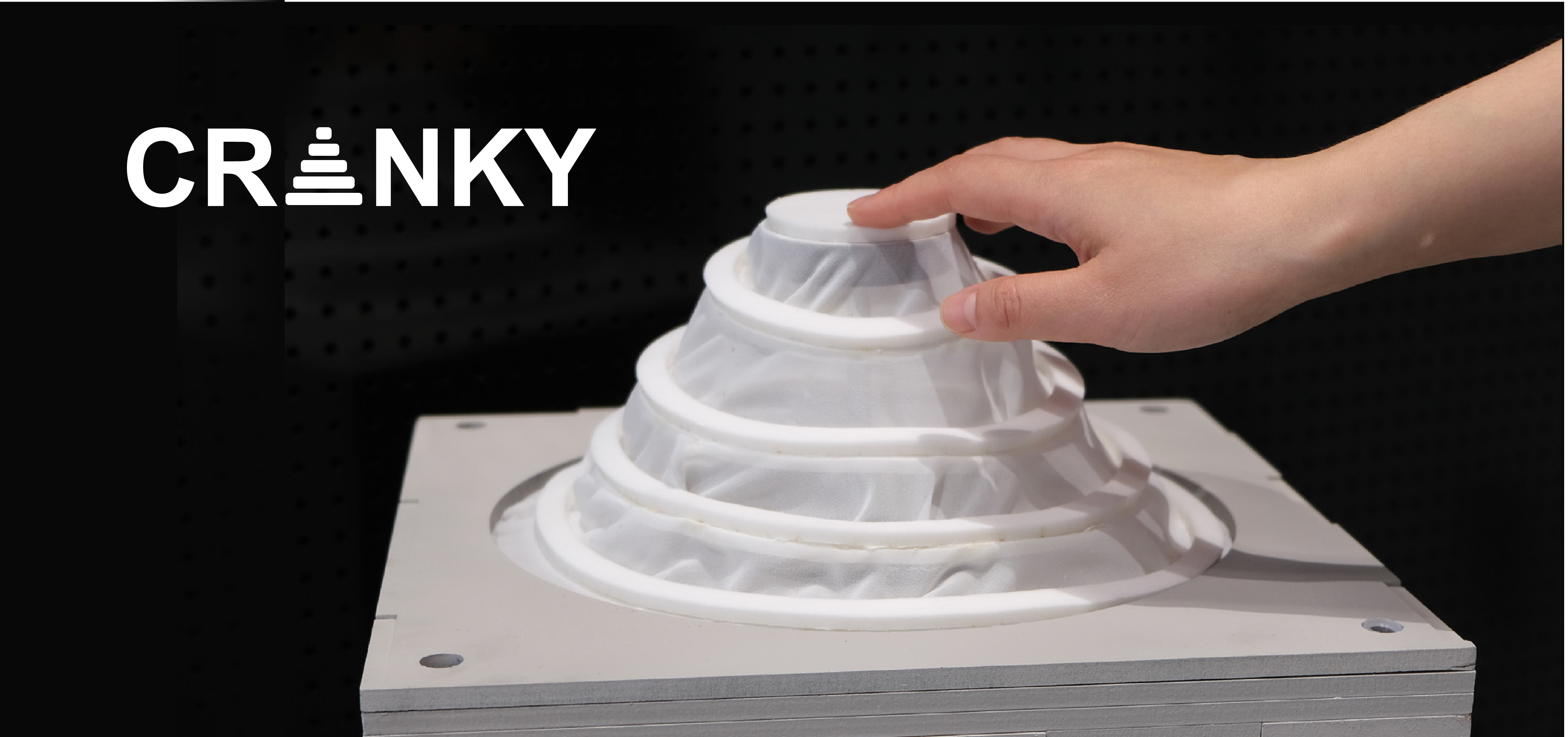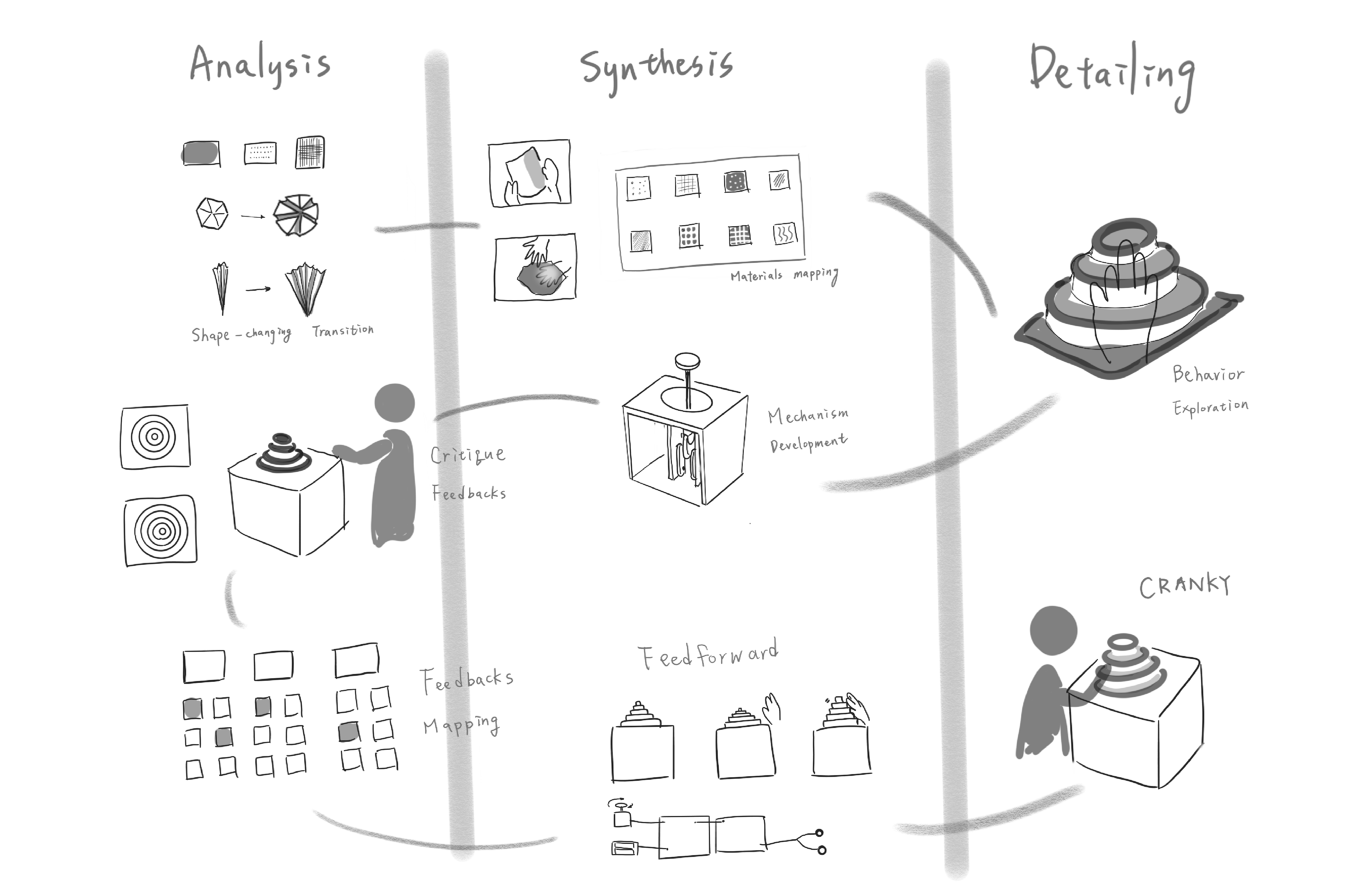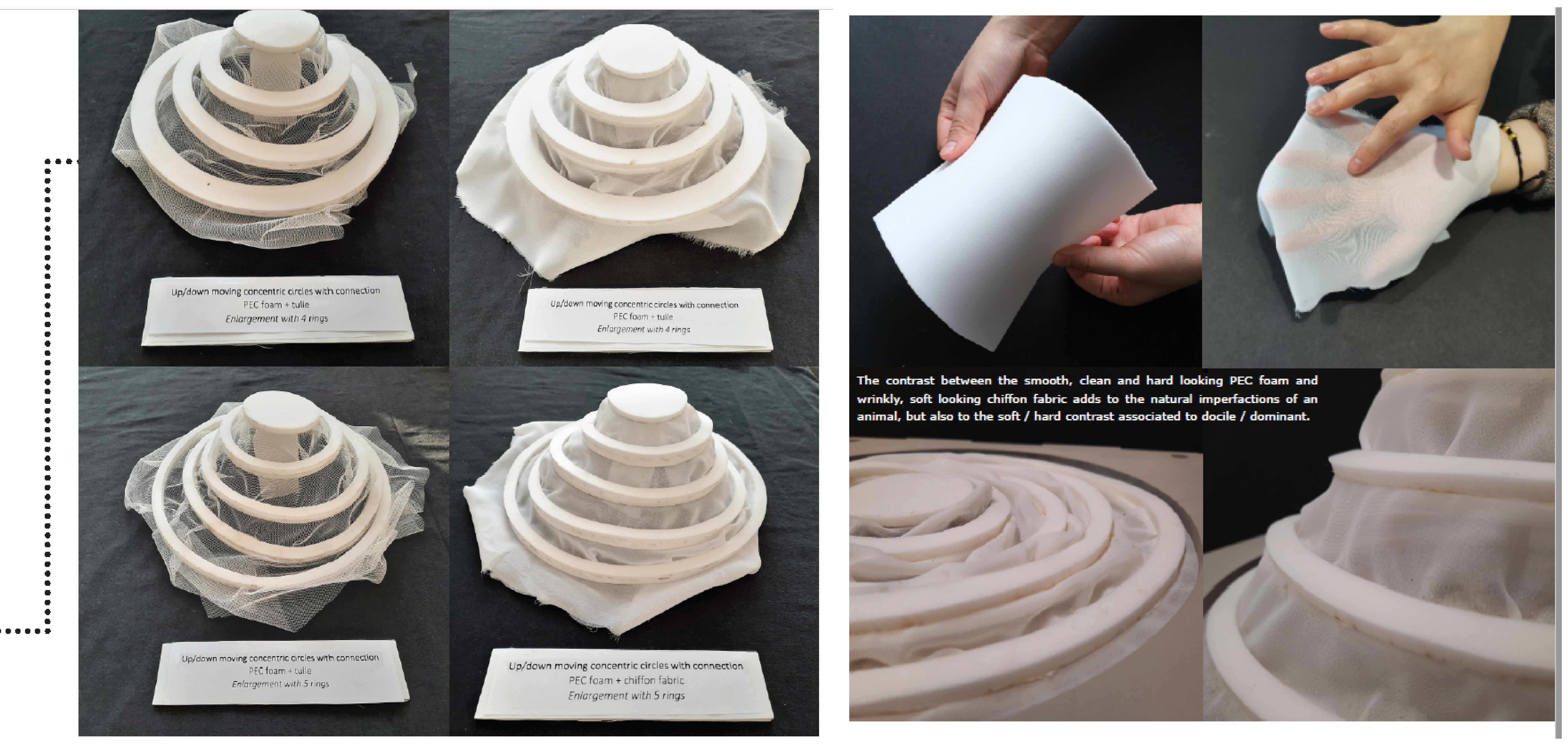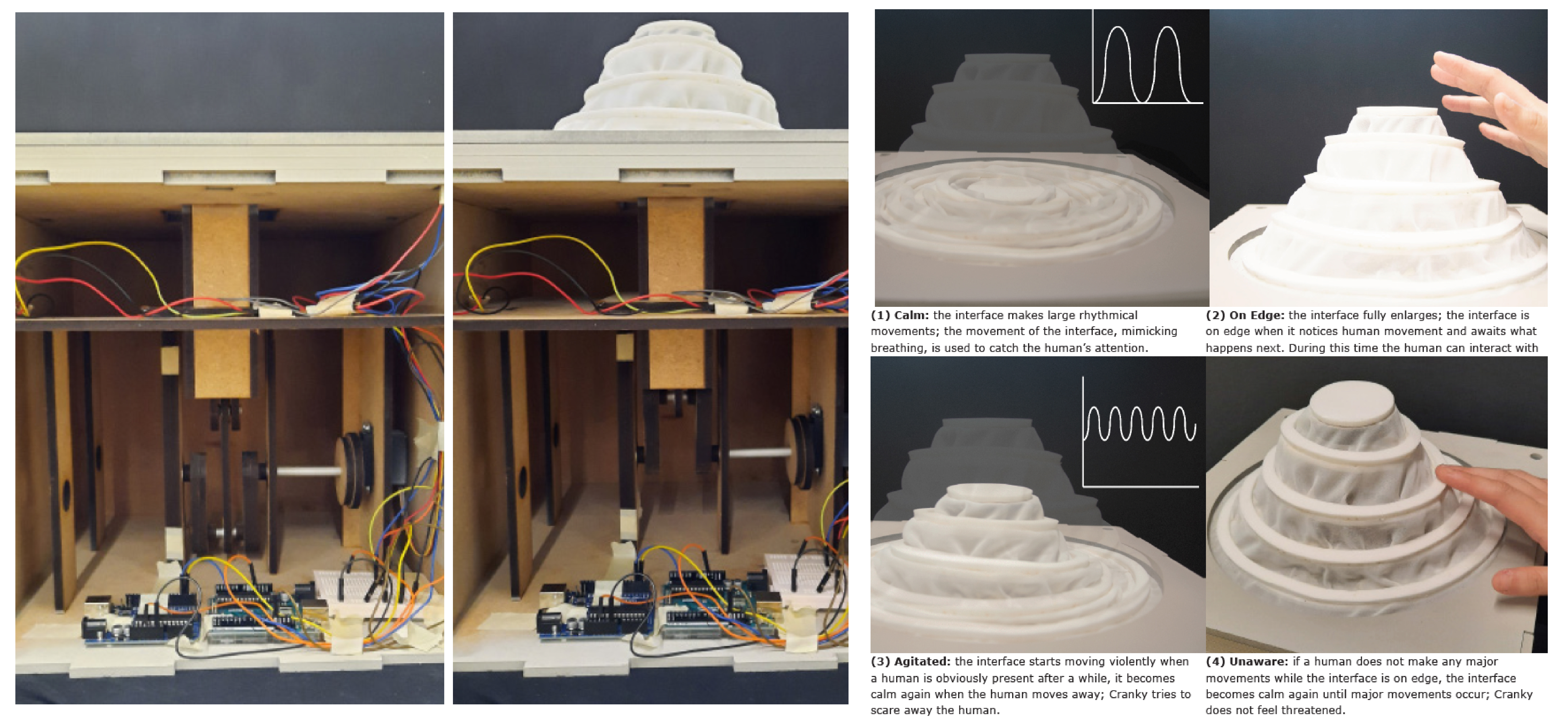
In the pictorial we discuss our design process, in which we took an interactive materiality approach to design. We first discuss the individual authors’ positioning in the literature. The pictorial is then mainly divided into four stages, which are Process, Analysis, Synthesis and Detailing. We first briefly describe our exploration process, including exploring multiple types of materials, shape-changing transition and the sensor-actuator mechanism. In the Analysis phase, we further concretize the final materials and the corresponding interaction which we ended up determining. In the Synthesis phase, we discuss all parts of the interface as a whole. In the phase of Detailing, we go further into the details of the system, such as the used sensors. Throughout the process, by a material perspective approach on design, we focus on exploring rich sensorial interaction, and aesthetic-centered quality by hands-on explorations. We conclude our pictorial with the authors their individual discussions and reflections.
| Time frame: | 09.2020-11.2020 |
| Category: | Interactive Materiality, Haptics, Shape Change. |
| Development: | Creativiy & Aesthetics, Design Research, Technology & Realization |
| Course: | Interactive Materiality |
| Share: |

The design research process using iterative process (Analysis, Synthesis, Detailing)
The design of Cranky was inspired by the animal transition of Docile to Dominant. In order to reach the final design a material based approach was taken. We started by exploring with origami and a form of Kirigam , in which we looked at a spiral pattern. The decision was made to use these spirals, since it can achieve more 3D enlargement in contrast to the origami structure we explored. This spiral pattern was translated to a few different materials. The final decision fell on PEC foam because of the ability to create precision spiral cuts with a laser cutter and it’s clean looks yet soft feeling. In order to make the appearance a whole we decided to fill the open gaps of the spiral with a connection material.
In order to still achieve the intended form of enlargement by “expanding” the material, we switched to concentric circles. For this we experimented with some different materials and connection methods such as thread and needle, and 3D printing with different flexibilities. Eventually we decided on using PEC foam as the ring can be nicely cut.

The exploration in the predetermined form of transition (Docile to Dominant) based on the characteristics of various materials.
We selected PEC foam for the rings and connected each ring with chiffon fabric. For added rigidness each ring consist of two layers of PEC foam. The distances between the rings allowed for adding a “overflow” of chiffon fabric to accommodate the enlargement. This overflow material causes wrinkling both when moving up and down or when static.
Observation from a showroom approach We noticed that more (slimmer) rings resulted in a more continuous shape when enlarging rather than creating obvious layered steps. Therefore, for the enlarging motion of the interface, inspiration was taken from a boiling hot spring. Where you can see a obvious enlargement of the water bubble before “exploding”. This bigger enlargement would be good for expressing dominance. With the sensor, material and mechanism together we explored the mapping of the material to interactions, based on the possibilities we created and arising limitations. We first designed for when a human approaches the interface, the material will enlarge. In this moment the human can touch the material and make judgements on the haptic experience of the PEC foam and Chiffon fabric. This is not really perceivable as a dominant behavior, so after a while we want to assert dominance again so we scare the human away by having the material shake violently as a way of breaking the interaction.
When a human moves away the interface will return to its initial behavior. If a human stays and doesn’t move, the sensors don’t notice the human. This limitation became inspiration for the interface not feeling threatened unless major movements are made. It would, therefore, also be interesting that over time one can learn to what magnitude their motions are noticed by the interface, allowing to be in its presence without it trying to show dominance. Ultimately, by learning it’s behavior and influencing it the user will become dominant.

The decisions made on the selected materials according to the explored behaviors of the interactive object and the potential interaction between human
Synthesis:
Combining the aspects of Material, Interaction and shape change resulted in Cranky; an interface based on the transition of Docile to Dominant. Cranky uses a shape change based behavior inspired by enlargement of animals who try to assert dominance. The temporal forms [6] are operated using proximity sensors and a servo driving a crankshaft mechanism sensing human interaction and shape change respectively. This computed causality can be subdivided in four states, where major human movements translate to sensing input.

The experiments between the mechanism and the actuated effects
The study’s goal is to investigate the feasibility of implementing the proposed persuading behavior change protocol in the context of routine activity at home while also investigating the scope for technological support by involving participants in situations where they have a motivated target diet goal to follow. The study is built on the need for more in-depth and contextual knowledge to explore and understand the complexity and adaptation in designing technologies with the goal of having a long-term impact on everyday diet-related practices. The anticipated outcomes seek to unearth issues related to user experiences and personal values that may emerge from self-reflection practices.
Encoded behaviors to investigate the interaction between an object and human
Despite the fact that the deviation exists in Cranky’s reaction and what the users have anticipated in their minds, the inviting movement does seamlessly draw human’s attention and encourage them to interact with Cranky. The movement of Cranky’s behavior guides the users in the right direction through an action-perception way
The Interactive Materiality approach
The interactive materiality approach enabled us to explore the interactions between an artifact and human from different perspectives in terms of aesthetic (Creativity & Aesthetics). Starting from how we inspired from the nature and a transition was formulated also concerning the characteristics of the used material. The knowledge of T&R (Technology & Realization) could be critical in building the interaction.,knowing the limitation from the technology, at the same time, telling the story which the displayed interaction can present.
A showroom study approach to provoke audience's reactions
A Showroom Research through Design approach (Design Research) allows our design process to be iteratively debated and validated with people in a form of exibitation. This further enables us to showcase our design to the audiences and reflect on their provoking-reactions.